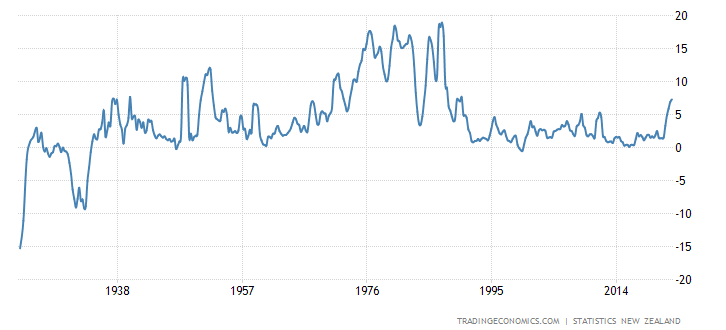
eurusd-is-falling-what-to-expect-from-the-future-price-movement

Don’t waste your time – keep track of how NFP affects the US dollar!
Data Collection Notice
We maintain a record of your data to run this website. By clicking the button, you agree to our Privacy Policy.

Beginner Forex Book
Your ultimate guide through the world of trading.
Check Your Inbox!
In our email, you will find the Forex 101 book. Just tap the button to get it!
Risk warning: ᏟᖴᎠs are complex instruments and come with a high risk of losing money rapidly due to leverage.
71.43% of retail investor accounts lose money when trading ᏟᖴᎠs with this provider.
You should consider whether you understand how ᏟᖴᎠs work and whether you can afford to take the high risk of losing your money.
Information is not investment advice
Inflation in New Zealand is the highest since 1990, edging to 7.3% in Q2 2022. The currency is under heavy pressure as the Reserve Bank of New Zealand is trying to reverse the inflationary spiral. The week ahead will give us a valuable clue about the country’s monetary policy, and we are here to talk about that.
The GDP growth in New Zealand reached 5% in 2021, making the economy one of the fastest-developing in Oceania. However, as the world suffered from geopolitical shocks and supply crunches, inflation started to speed up. Although the direct impact of the Russian invasion of Ukraine is limited due to their small shares in New Zealand’s trade, the indirect effect is present. Rising commodity and energy prices gradually increased the cost of living, pressing on businesses and consumers.
Currently, inflation stays at 7.3%, the highest since 1990, and may become two-digit as tourism rebounds from the Covid-19 lockdowns.

Source: tradingeconomics.com
The unemployment level is at a historic low (3.2%), but the labor market lacks skilled workers. Moreover, when the country reopened the border in March 2022, the outflow of migrants soared. That happened because workers needed new work visas and had to wait till July 2022 to get them. All this increases pressure on the labor market and pushes prices even higher.
The Reserve Bank of New Zealand (RBNZ) will publish its Official Cash Rate on Wednesday, October 5, 04:00 GMT+3. The RBNZ’s deputy governor Christian Hawkesby said the bank considered a rate increase between 25 and 75 points before deciding to raise the rate by 50 basis points this month. As he said, once rates get to 4.0-4.25%, the bank will understand the monetary policy and the economic performance better.
As the current rate is at 3.0%, we expect the bank to make at least three consecutive rate changes. The closest one will probably be a 50-basis-point, followed by two 25-s, or a 50 and a 25. We expect the downturn in New Zealand’s economy to slow as the tightening cycle ends.
According to Organization for Economic Co-operation and Development (OECD) report, economic growth will slow from 5.0% in 2021 to 3.0% in 2022 and 2.0% in 2023. Therefore, the country is likely to withstand global recession with its head held high.

As the NZD remains under pressure, especially against the strong USD, we can spot signs of an upcoming reversal o a daily chart. First, the RSI is in the oversold zone. Generally a buy signal, it worked four out of five times over the last year.
Moreover, the RBNZ Rate Statement, which comes right after the Cash Rate announcement, may come along with our suggestions on future rate changes. It will give some relief to the NZD bulls and push the NZDUSD pair to the resistance trendline.
A less likely scenario is unexpectedly hawkish comments from the bank’s members that may push the pair above the trendline and bring it to the 50-period MA.
NZDUSD daily chart
Resistance: 0.5800, 0.6000
Support: 0.5560


eurusd-is-falling-what-to-expect-from-the-future-price-movement

Greetings, fellow forex traders! Exciting news for those with an eye on the Australian market - the upcoming interest rate decision could be good news for Aussies looking to refinance or take out new loans. The Mortgage and Finance Association Australia CEO, Anja Pannek, has...

Hold onto your hats, folks! The Japanese yen took a nosedive after the Bank of Japan (BOJ) left its ultra-loose policy settings unchanged, including its closely watched yield curve control (YCC) policy. But wait, there's more! The BOJ also removed its forward guidance, which had previously pledged to keep interest rates at current or lower levels. So, what's the scoop? Market expectations had been subdued going into the meeting, but some were still hoping for tweaks to the forward guidance to prepare for an eventual exit from the bank's massive stimulus

eurusd-is-falling-what-to-expect-from-the-future-price-movement

Greetings, fellow forex traders! Exciting news for those with an eye on the Australian market - the upcoming interest rate decision could be good news for Aussies looking to refinance or take out new loans. The Mortgage and Finance Association Australia CEO, Anja Pannek, has...

Hold onto your hats, folks! The Japanese yen took a nosedive after the Bank of Japan (BOJ) left its ultra-loose policy settings unchanged, including its closely watched yield curve control (YCC) policy. But wait, there's more! The BOJ also removed its forward guidance, which had previously pledged to keep interest rates at current or lower levels. So, what's the scoop? Market expectations had been subdued going into the meeting, but some were still hoping for tweaks to the forward guidance to prepare for an eventual exit from the bank's massive stimulus
Your request is accepted.
We will call you at the time interval that you chose
Next callback request for this phone number will be available in 00:30:00
If you have an urgent issue please contact us via
Live chat
Internal error. Please try again later